Travertine

Produktbeschreibung
Travertine is a form of limestone deposited by mineral springs, especially hot springs. Travertine often has a fibrous or concentric appearance and exists in white, tan, and cream-colored varieties. It is formed by a process of rapid precipitation of calcium carbonate, often at the mouth of a hot spring or in a limestone cave. In the latter, it can formstalactites, stalagmites, and other speleothems. It is frequently used in all over the world as a building material. This stone is perfect for both: interior and exterior.
Travertine is often used as a building material. The Romans mined deposits of travertine for building temples, aqueducts, monuments, bath complexes, and amphitheaters such as the Colosseum, the largest building in the world constructed mostly of travertine.
Other notable buildings using travertine extensively include the Sacré-Cœur Basilica in Paris and the 20th-centuryGetty Center in Los Angeles, California, and Shell-Haus in Berlin. The travertine used in the Getty Center and Shell-Haus constructions was imported from Tivoli and Guidonia.
Travertine is one of several natural stones that are used for paving patios and garden paths. It is sometimes known as travertine limestone or travertine marble; these are the same stone, although travertine is classified properly as a type of limestone, not marble. The stone is characterised by pitted holes and troughs in its surface. Although these troughs occur naturally, they suggest signs of considerable wear and tear over time. Some installers use a grout to fill the holes, whereas others leave them open — travertine can be purchased “filled” or “unfilled.” It can also be polished to a smooth, shiny finish, and comes in a variety of colors from grey to coral-red. Travertine is most commonly available intile sizes for floor installations.
Travertine is one of the most frequently used stones in modern architecture. It is commonly used for façades, wallcladding, and flooring. The lobby walls of the modernist Willis Tower (1970) (formerly Sears Tower) in Chicago are made of travertine. Architect Welton Becket frequently incorporated travertine into many of his projects. The first floor of the Becket-designed UCLA Medical Center has thick travertine walls. Architect Ludwig Mies van der Rohe used travertine in several of his major works, including the Toronto-Dominion Centre, S.R. Crown Hall and the Farnsworth House.
The relative softness of the stone, combined with its holes and troughs, make travertine flooring difficult to finish and maintain. Aggressive grinding — sometimes called honing — can reveal previously hidden air pockets that significantly change the look of the floor. Travertine tiles come in different colours and shades, and are distinguished for their appealing and elegant look. They are ecologically safe and with no radiation discharge. We strongly recommend to use our travertine tiles in decoration and refurbishing of your apartments, houses and offices.

